10,000 Years Ago 
Paleo-Indians first visited the Las Vegas valley hundreds of years ago. They lived as nomads, traveling and camping in different locations. These people left behind petroglyphs that help us tell our early history.
2,000 Years Ago
Anasazi Indians move into southern Nevada and live along the Muddy and Virgin rivers. The ?Lost City? are ruins of the Anasazi community that can be found in Overton, Nevada, northwest of Las Vegas. The Pauite people also explored the Las Vegas area.
1829
A young scout named Rafael Rivera is the first person of European ancestry to look upon the valley. His discovery of a valley with abundant wild grasses growing and a plentiful water supply reduces the journey by several days. The valley is named Las Vegas, Spanish for "The Meadows."
1844
John C. Fremont arrived in Las Vegas and kept a journal describing two springs he found. These writings were very popular and lured many individuals to the area.
1855
Members of the Mormon Church choose Las Vegas as the site to build a fort halfway between Salt Lake City and Los Angeles, where they would travel to gather supplies. The remainder of the
Mormon Fort 
can still be seen at the intersection of Las Vegas Boulevard and Washington Avenue. The fort was abandoned several years later.
1864
Nevada is admitted into the union as the 36th state. This day is recognized annually as a state holiday.
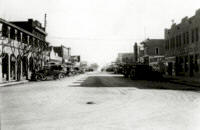 1885
1885
The State Land Act of 1885 offers sections of land at $1.25 per acre. Farmers move in and agriculture becomes the dominant industry for the next 20 years.
Late 1800's
The discovery of minerals, including precious metals, leads to the beginning of the mining industry.
 Early 1900s
Early 1900s
The completion of the main railway, linking Southern California with Salt Lake City, establishes Las Vegas as a railroad town. The availability of water makes Las Vegas an ideal refueling point and rest stop.
1905
Las Vegas is founded as a city on May 15, 1905, when 110 acres of land situated between Stewart Avenue on the north, Garces Avenue to the south, Main Street to the west, and 5th Street (Las Vegas Boulevard) to the east, are auctioned off.
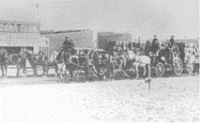 Freight Wagon on Fremont Street
Freight Wagon on Fremont Street
1911
Las Vegas is incorporated on June 1, 1911. On that day, voters in the unincorporated township of Las Vegas went to the polls and voted on the issue of incorporation. The results? 168 in favor of incorporation and 57 opposed. The population stands at 800. Clark County has a population of 3,321.
Divorce laws are liberalized in the State of Nevada, making residency easier to attain. A "quickie" divorce can be attained after six weeks of residency. These short-term residents stay at "dude ranches" which are the forerunners of the sprawling Strip hotels.
1930
Las Vegas grows to a population of 5,165.
1931
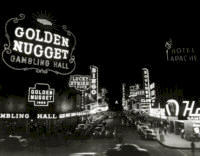
Beginning in 1931, the construction of Hoover Dam brings an influx of construction workers which starts a population boom and gives the Valley's economy, which was in the grips of the Great Depression, a needed boost.
- While gambling took place illegally for many years, it was officially legalized in March 1931 by the state legislature.
1935
Hoover Dam is complete. At 726 feet high and more than 1,200 feet long when built, it was the tallest dam in the world. President Franklin D. Roosevelt spoke at the dam?s dedication.
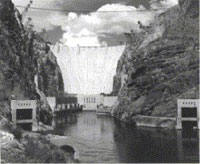
1940's
Las Vegas' population has grown to 8,422. The outbreak of World War II brings the defense industry to the valley. The isolated location, along with plentiful water and inexpensive energy, makes Las Vegas an ideal site for military and defense related industries. The site for Nellis Air Force Base is located in the northeast, and the Basic Management Complex, providers of raw materials, is located in the southeastern suburb of Henderson. The defense industry continues to employ a significant number of valley residents.
1944
In 1944, the city of Las Vegas begins to operate council / manager form of government. Previous to this date, the city was operated as a ?commission? form of government.
1945
Following World War II, lavishly decorated resort hotels and gambling casinos offering top-name entertainment come into existence. Tourism and entertainment took over as the largest employer in the valley.
1951
The first atomic bomb is detonated at the Nevada Test Site north of Las Vegas. People flocked to watch the tests until the limited Test Ban Treaty of 1963 required that nuclear tests be moved underground.
Moulin Rouge, Las Vegas' first racially integrated hotel, opens its doors
1956
The city of Las Vegas annexes one square mile of land, its first such addition since incorporation 45 years earlier.
1957
Topless Showgirls debut on the Strip with "Minsky's Follies."
1959
"Welcome to Fabulous Las Vegas" sign is created by Betty Willis.
The Nevada State Legislature creates the Nevada Gaming Commission.
1960
During the 1960s, a phenomenon led by Howard Hughes, occurs in Las Vegas. Corporations are building and/or buying hotel/casino properties. They have the capital necessary and the profitability makes entrance into the casino industry extremely attractive. Gambling becomes "gaming" and starts the transition into legitimate business.
1969
Elvis Presley opens at the International Hotel, now known as the Las Vegas Hilton.
1970-1980
Corporations continue to invest in the hotel/casino industry. Gaming becomes a legitimate business and some properties have stock traded on the market.
1980
Las Vegas economy remains strong and the population increases to 164,674. Clark County, meanwhile, grows to a population of 463,087.
1980's
Starting in the mid 1980s, a period of unprecedented growth begins. Annual population increases averaging nearly 7 percent causes the city's population to almost double between 1985 and 1995, increasing from 186,380 to 368,360, a 97.6 percent increase. That is equivalent to building a city larger than Reno in 10 years! At the same time, Clark County's population increases from 562,280 to 1,036,180, an increase of 84.3 percent.
1990's
Contributing to the population growth is a 4 percent annual increase in hotel rooms and a 9.18 percent annual increase in jobs
1993
The Dunes Hotel is imploded.
 1995
1995
The Fremont Street Experience opens. The $70-million canopy above Fremont Street provides visitors with spectacular light and sound show.
2000
The US Census reports the population of Las Vegas is 478,434 over a land area of 113 square miles. There are over 500 churches and synagogues, 799 acres of parks, 7 television stations, and 12 radio stations (4 AM and 8FM). Las Vegas is the largest metropolitan city in the U.S. that was founded in 20th century.
The Las Vegas City Council grows from four wards to six. A vote of the people in 1999 approved an advisory ballot question allowing this change.
2005
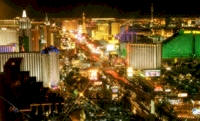 The city of Las Vegas celebrated its 100th birthday on May 15, 2005. The events celebrated the May 15, 1905 auction in which 110 acres of downtown Las Vegas laid the foundation for the city we know today. The celebration began on December 31, 2004, and lasted throughout 2005.
The city of Las Vegas celebrated its 100th birthday on May 15, 2005. The events celebrated the May 15, 1905 auction in which 110 acres of downtown Las Vegas laid the foundation for the city we know today. The celebration began on December 31, 2004, and lasted throughout 2005.
June 2007
The Las Vegas Springs Preserve , a cultural and historical experience just miles from downtown Las Vegas opens to the public. The 180-acre national historic site is commonly referred to as the "birthplace of Las Vegas."
August 2007
The three-block area known as the Fremont East Entertainment District opens. As part of its downtown revitalization efforts, the city?s Redevelopment Agency contributed funds to this renovation in an effort to attract additional non-gaming nightclubs, cocktail lounges and entertainment hotspots to the area.
May 26, 2009
The Smith Center for the Performing Arts , which is located on the 61-acre mixed-use urban community Symphony Park, celebrated its groundbreaking with a bell ringing.
November 2009
The city celebrates the designation of Las Vegas Boulevard, from Washington Avenue to Sahara Avenue, as a National Scenic Byway with a neon sign lighting ceremony.
Feb. 2, 2010
Demolition begins to make way for a new City Hall and mixed-use office project in downtown Las Vegas, creating more than 13,000 jobs and providing more than $4 billion in investment.
Feb. 14, 2012
The National Museum of Organized Crime and Law Enforcement opens inside in a former federal courthouse turned post office located at 300 Stewart Ave.
Feb. 27, 2012
The new City Hall, located at 495 S. Main Street, opens for business in downtown Las Vegas, leaving the previous City Hall available for development by Zappos.com
Thanks to
Sources:
City of Las Vegas
Clark County
Las Vegas Convention and Visitors Authority
State of Nevada
U.S. Census Bureau
Las Vegas Age - June 3, 1911
Ainley, Thomas ?Taj? Jr. and Gabaldon, Judy Dixon. Las Vegas: The Fabulous First Century. Arcadia Publishing, 2003.
Moehring, Eugene P. and Green, Michael S. Las Vegas: A Centennial History. University of Nevada Press, 2005.
Land, Barbara and Land, Myrick. A Short History of Las Vegas. University of Nevada Press, 2004.
Peters, Jonathan Ph.D. Springs In The Desert: A Kid's History Of Las Vegas. Stephens Press, 2007.

 1885
1885 Freight Wagon on Fremont Street
Freight Wagon on Fremont Street Beginning in 1931, the construction of Hoover Dam brings an influx of construction workers which starts a population boom and gives the Valley's economy, which was in the grips of the Great Depression, a needed boost.
Beginning in 1931, the construction of Hoover Dam brings an influx of construction workers which starts a population boom and gives the Valley's economy, which was in the grips of the Great Depression, a needed boost.

 The city of Las Vegas celebrated its 100th birthday on May 15, 2005. The events celebrated the May 15, 1905 auction in which 110 acres of downtown Las Vegas laid the foundation for the city we know today. The celebration began on December 31, 2004, and lasted throughout 2005.
The city of Las Vegas celebrated its 100th birthday on May 15, 2005. The events celebrated the May 15, 1905 auction in which 110 acres of downtown Las Vegas laid the foundation for the city we know today. The celebration began on December 31, 2004, and lasted throughout 2005.